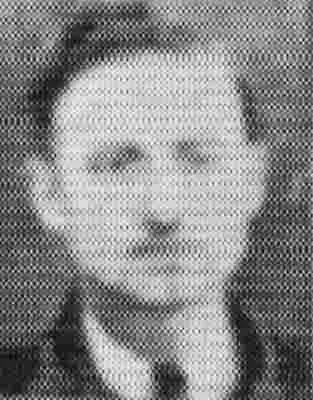Langford, Patrick Wilson
Prisoner of War Executed 1944-03-31


Birth Date: 1919-November-04
Born: Edmonton, Alberta
Son of Captain Richard Wilson Langford and Olive Mary (nee Stevens) Langford, of Victoria, British Columbia. Brother of Richard Dennis and Diana Mary.
Home: Vancouver, British Columbia
Enlistment: Edmonton, Alberta
Enlistment Date: 1940-01-29
Decorations: MiD

Service
RCAF
Unit
16 OTU- Operational Training Unit (RAF)
Base
Rank
Flight Lieutenant
Position
Flight Lieutenant
Service Numbers
C/1631
First Burial
 Old Garrison Cemetery At Poznan, Poland
Old Garrison Cemetery At Poznan, Poland
Previous Events
1942-July-29 Flight Lieutenant Prisoner of War Executed
Wellington IC | 16 OTU |
Took off from Upper Heyford at 22:14 in Wellington Mark IC (Sqn code: Y1 Bomber Command). Crashed over Scjleswig Executed by Gestapo 31st March 1944 following the 'Great Escape' from Stalag Luft lll, Sagen. Recaprured in Gorlitz area. Cremated at Liegnitz. He had been in charge of the trapdoor entrance to the tunnel | |
Stories and Videos
The Great Escape: Canadian Airmen Role
The Movie by the same name implies that The Great Escape was an American operation. It was not.It was primarily a British Commonwealth Operation and Canadian airmen had a very prominent role. In fact six Canadian airmen who were captured after escape were executed by German forces.
 The True Story Of The Great Escape
The True Story Of The Great Escape
Further Reading:
- THE GREAT ESCAPE: A CANADIAN STORY by Ted Barris
- THE GREAT ESCAPE by Paul Brickhill
The Escape
Seventy-six Allied Officers escape from Prisoner of War Camp Stalag Luft 3. 50 were subsequently murdered in retaliation for their escape attempt on the order of Adolph Hitler. 15 were recaptured, and 11 escaped.
6 - RCAF
4 - RAAF
2 - RNZAF
2 - SAAF
2 - Norway (RAF)
1 - France (RAF)
1 - Greece (RAF)
| 32 - RAF
|
Vickers Wellington

Vickers Wellington B. Mk. III (Serial No. X3763), coded KW-E, No. 425 'Alouette' (B) Squadron, RCAF, late summer of 1942
The Vickers Wellington was a British twin-engined, long-range medium bomber. It was designed during the mid-1930s at Brooklands in Weybridge, Surrey. Led by Vickers-Armstrongs' chief designer Rex Pierson, a key feature of the aircraft is its geodetic airframe fuselage structure, which was principally designed by Barnes Wallis. Development had been started in response to Air Ministry Specification B.9/32, issued in the middle of 1932, for a bomber for the Royal Air Force. This specification called for a twin-engined day bomber capable of delivering higher performance than any previous design.
The Wellington was used as a night bomber in the early years of the Second World War, performing as one of the principal bombers used by Bomber Command. During 1943, it started to be superseded as a bomber by the larger four-engined "heavies" such as the Avro Lancaster. The Wellington continued to serve throughout the war in other duties, particularly as an anti-submarine aircraft.
It holds the distinction of having been the only British bomber that was produced for the duration of the war, and of having been produced in a greater quantity than any other British-built bomber. The Wellington remained as first-line equipment when the war ended, although it had been increasingly relegated to secondary roles. The Wellington was one of two bombers named after Arthur Wellesley, 1st Duke of Wellington, the other being the Vickers Wellesley.
In August 1936, an initial order for 180 Wellington Mk I aircraft, powered by a pair of 1,050 hp (780 kW) Bristol Pegasus radial engines, was received by Vickers; it had been placed so rapidly that the order occurred prior to the first meeting intended to decide the details of the production aircraft. In October 1937, another order for a further 100 Wellington Mk Is, produced by the Gloster Aircraft Company, was issued; it was followed by an order for 100 Wellington Mk II aircraft with Rolls-Royce Merlin X V12 engines. Yet another order was placed for 64 Wellingtons produced by Armstrong Whitworth Aircraft. With this flurry of order and production having been assured by the end of 1937, Vickers set about simplifying the manufacturing process of the aircraft and announced a target of building one Wellington per day.
A total of 180 Wellington Mk I aircraft were built; 150 for the RAF and 30 for the Royal New Zealand Air Force (RNZAF) (which were transferred to the RAF on the outbreak of war and used by 75 Squadron). In October 1938, the Mk I entered service with 9 Squadron. The Wellington was initially outnumbered by the Handley Page Hampden (also ordered by the Ministry to B.9/32) and the Armstrong Whitworth Whitley (to B.34/3 for a 'night' bomber) but outlasted both rival aircraft in service. The Wellington went on to be built in 16 separate variants, in addition to two training conversions after the war. The number of Wellingtons built totalled 11,462 of all versions, a greater quantity produced than any other British bomber. On 13 October 1945, the last Wellington to be produced rolled out.Wikipedia
 Canadian Virtual War Memorial
Canadian Virtual War Memorial
 Wikipedia Vickers Wellington
Wikipedia Vickers Wellington RCAF - Vickers Wellington
RCAF - Vickers Wellington